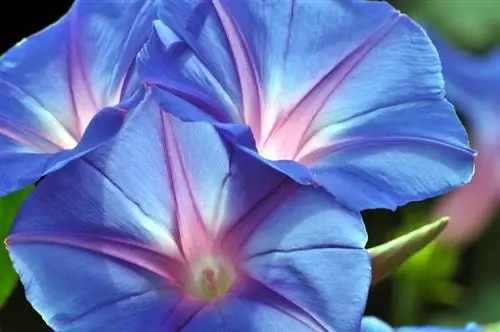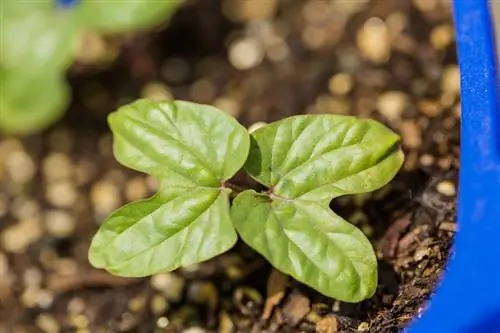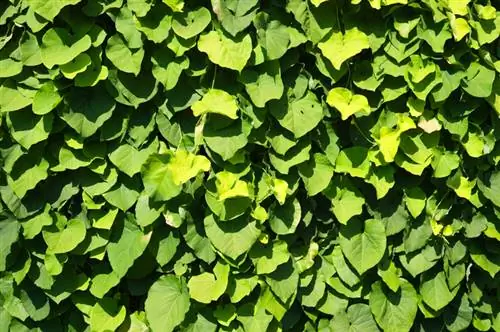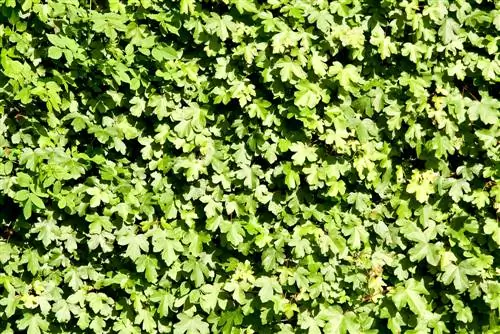- Author admin [email protected].
- Public 2023-12-25 17:45.
- Last modified 2025-01-23 11:20.
Unsightly arbors, dreary walls and steel obelisks transform the morning glory into a spectacular sea of flowers. This annual climbing plant does not require any time-consuming care for this floral masterpiece. Are you still worried about some questions about cultivation? Then read compact answers directly from garden practice here.

How do you care for morning glories in the garden?
Morning glories require a full sun, wind-protected location, loamy and well-drained soil. They should be kept slightly moist and watered regularly. For an ideal supply of nutrients, weekly fertilization and regular removal of wilted flowers are recommended.
Planting morning glories correctly
The morning glory, which has been hardened on the balcony for over 2 weeks, will take its place in the garden from mid-May. In a fully sunny, protected location, loosen the soil finely and dig small pits at a distance of 30-50 cm. Shovel the soil into a wheelbarrow to enrich it with compost, bark humus, horn shavings or sand, as needed. After the root ball has been thoroughly immersed in water, carefully pot up and plant the morning glories. Please pay special attention to the delicate tendrils as they tear quickly. If possible, maintain the existing planting depth and water generously.
Care tips
In terms of its care requirements, the morning glory proves to be a plant without any airs and graces. This is particularly true if the location meets all important framework conditions. How to properly care for the morning glories:
- Keep the soil constantly slightly moist with occasional drying phases
- From May to October, fertilize liquid weekly or treat yourself with compost and horn shavings every 14 days
- Clean out wilted flowers as soon as possible to make room for the floral successors
In autumn, cut the morning glories close to the ground or dig up the plants including the root ball.read more
Which location is suitable?
The careful choice of location sets the stage for a phenomenal abundance of flowers. The funnel winch attaches particular importance to the following general conditions:
- Full sunny location, warm and sheltered from the wind
- Normal garden soil, preferably clayey, humus-rich and well-drained
Ideally, the Ipomoea winds itself towards the sky under the protection of a eaves or an awning, because pelting rain causes the magnificent bell-shaped flowers to wither.
What soil does the plant need?
The morning glory feels at home in loamy garden soil, fresh, moist, humus-rich and well-drained. A neutral pH value is welcome, although slight swings in the acidic or alkaline direction are tolerated. Where the soil does not meet your expectations, soil additives compensate for any deficiencies. Sandy-dry soil is optimized with the help of compost and bark humus. Compacted soil is given a loose consistency with quartz sand and leaf mold.
When is flowering time?
From June to October, the morning glory boasts a dense pile of colorful bell flowers. Since the individual flowers only last a few days, clean out wilted stems regularly. Thanks to this care, the buds underneath have a clear path to sunlight, so that the morning glory maintains its well-groomed, lush appearance.
Cut the funnel winch correctly
Cut off wilted flowers as soon as possible. There are already numerous new buds underneath, which will quickly find their way to the sunlight. If the morning glory takes on undesirable dimensions, it can be cut back at any time. If the blossom festival is coming to an end in autumn, cut the morning glory close to the ground. If possible, leave the roots in the soil, much to the delight of busy soil organisms.
Watering morning glory
The location and weather conditions determine the watering requirement. The brighter the location and drier the summer, the more abundant the watering is. Check daily whether the soil has dried out. If the top 1-2 cm feel dry, use the watering can. Although morning glories require a lot of water, they do not want to have to deal with waterlogging. Therefore, let the water run slowly onto the root ball and stop as soon as a puddle forms.
Fertilize morning glory properly
In order to produce the enormous biomass, the constant supply of nutrients plays a central role in the care program. Fertilize the morning glory weekly with mineral-organic liquid fertilizer from May until the end of the flowering period. Alternatively, work ripe compost superficially into the soil every 1-2 weeks and then water extensively.
Propagate morning glory
Sowing has proven to be excellent for the propagation of annual morning glories. This also applies to cultivation if you are cultivating this gem in the garden for the first time. The following short instructions show how to do it:
- In March, fill small pots with seed soil or peat sand and moisten them
- Soak the fine seeds overnight to sow them thinly
- Sift 0.5 cm over with sand or substrate and put a plastic bag over it
At a constant 20-25 degrees Celsius in a partially shaded window seat, germination takes 10-21 days. Prick the strongest seedlings into 8 cm pots when 2 or more pairs of leaves have formed. Keep the soil slightly moist until planting in mid-May. From the end of April, fortnightly doses of diluted liquid fertilizer will give your pupils the boost they need.
Morning glories in a pot
In a large pot with an integrated trellis or obelisk, the morning glory provides a flower-filled interlude on the balcony and terrace. A good compost-based potting soil contains all the important ingredients for summer splendor. Spread a few pieces of pottery or pebbles on the ground before filling in the substrate. Plant the young Ipomoea carefully as the tender shoots could tear. Care is all about maintaining a balanced water and nutrient balance. Always water when the substrate has dried out. The climbing artist is happy about a weekly dose of liquid fertilizer from May until the end of the flowering period. Since the withered flowers are not conducive to a decorative look and hinder fresh buds, clean them out every few days. In this way you prevent the development of the capsule fruits with the poisonous seeds.
Is morning glory poisonous?
The seeds of morning glory contain various toxins that can cause life-threatening symptoms of poisoning if consumed. Therefore, do not cultivate the tropical climbing plant within the reach of children and pets. We also recommend careful handling of seeds that you have collected or purchased yourself.read more
Beautiful varieties
- Sunrise Serenade: Premium variety with double crimson flowers and white throat; winds up 2-3 m
- Kniola’s Black: Magnificent Ipomoea purpurea, whose dark red flowers adorn a cherry-red throat; 180-240 cm height
- Seta: Charming morning glory with white flowers, pink markings and dark green foliage; 250cm
- Blu: Light blue morning glory with countless bell-shaped flowers for walls, arbors and trellises; 250-300cm
- Cardinal Climber: Hard-working climber that stands out with bright red flowers and slitted leaves; 100-200cm






